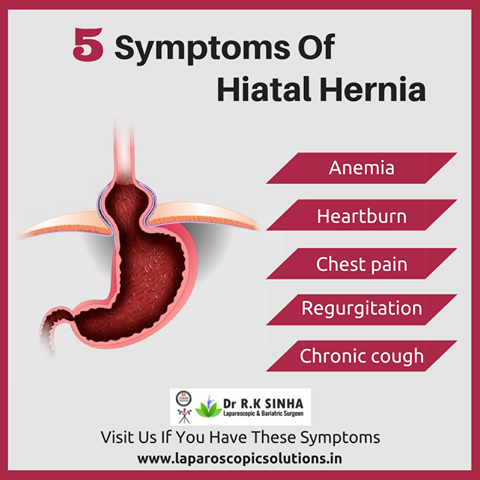Esophagus passes through an opening in the diaphragm (i.e. hiatus) on its way to connect to the stomach. Hiatal hernias occur when the muscle tissue surrounding hiatus becomes weak, causing the bulging of the upper part of the stomach through the diaphragm into the chest cavity. It is generally caused due to obesity, pregnancy, aging, or thinning of the phrenoesophageal membrane.
Symptoms of Hiatal Hernia
A small hiatal hernia generally does not cause any symptom and need no treatment. But an enlarged hernia can cause following symptoms:
-
Heartburn - 30 - 60 minutes after eating
-
Regurgitation of stomach contents that gets worsened with lying flat
-
Excessive belching
-
Aspiration (reflux of stomach contents into the airway)
-
Asthma
-
Pain or burning in chest
-
Difficult or painful swallowing
-
Vomiting blood or passing black stools
Diagnosis of Hiatal Hernia
It is often diagnosed while diagnosing the reason of heartburn or chest or upper abdominal pain by performing following evaluations:
-
Physical examination
-
Chest X-ray
-
Air fluid level in the chest
-
Esophagram (barium swallow)
-
Upper endoscopy
-
Upper endoscopy
-
Esophageal manometry
Laparoscopic Cruroplasty and Nissen fundoplication for Hiatal Hernia
Laparoscopic Cruroplasty and Nissen fundoplication is the procedure of choice for repair of a symptomatic as well as asymptomatic hiatal hernia.The laparoscopic Cruroplasty and Nissen fundoplication is performed through five quarter-inch incisions. Laparoscope and other instruments are inserted through these incisions. The hernia is reduced from the chest into the abdomen. This may require separation of abdominal organs from the lung and middle chest structures. This is followed by repair of hiatus to its appropriate size and construction of a new lower esophageal valve. Prosthetic material is used in cases of large hernias with poor tissue to prevent recurrence. The procedure takes about two to four hours depending on the size and contents of the hernia.
Advantages of Laparoscopic Cruroplasty and Nissen fundoplication for Hiatal Hernia Repair
-
Faster recovery
-
Only few hours or overnight hospitalization
-
Sooner return to work
-
Very less pain during and after the procedure
-
Smaller incisions without any cut on abdominal muscles
-
Negligible risks and complications
-
Less chances of wound infection
-
High success rate with more than ninety-percent of symptom free patients after ten years of the procedure









